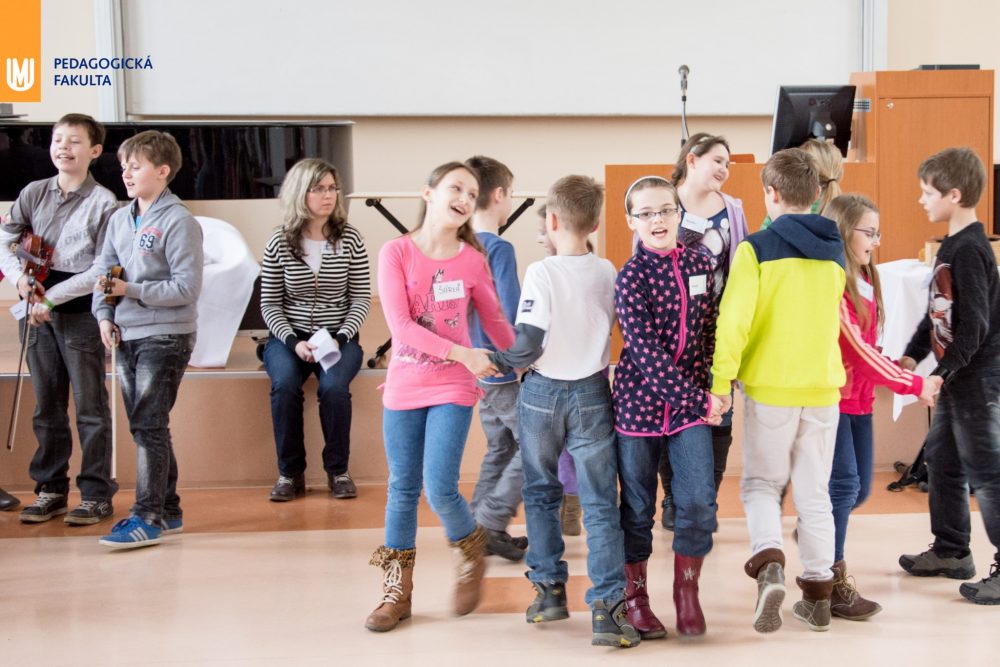Summary
One of the specific groups of songs are dance melodies related to dances with change of 2-beat and 3-beat time called mateníky. In these songs, 2/4 and 3/4 or 2/4 and 3/8 time change most often.
This Element 1 introduces ideas of working with especially the rhythmical part of the song Chytil sem slepici (west Moravia). The important file of music process is the reflection of metre-rhythmical structure of the melody, resp. changing of even and odd metre. In the activities with the song, the interpretation (vocal, instrumental, movement) and perceptive activities overlap, while the metre-rhythmical file is significant. Creative elements are included in the games with words rhythm, body play and dance expression, or in the creation of an instrumental accompaniment for a song.
References: Module 1, Element 2
Duration: 90 min
Key words creativity & entrepreneurship: Imagination, Sensibility for problems diversity, Working in teams (music groups), Transformation in production, Identification of problems, Imagination, Development of ideas and solutions
Description
Step 1
The pupils listen to the song Chytil sem slepici [I caught a hen] played by a cimbalom band.
The song text: I caught a hen, in the night in the street, nobody knows what it was like, nobody liked it.

Phonetic transcription: /xɪtɪl sɛm slɛpɪcɪ v nɔcɪ na ʊlɪcɪ, ʒa:dnɛj nɛvi: jaka: bɪla, ʒa:dni:mʊ sɛ nɛli:bɪla/
During the repeated listening, the pupils perceive the metric pulsation (changes of time), they learn the term mateník. They try to express alternating 2/4 and 3/4 times by playing the body (e. g. strong beat – clapping, weak beat – slapping) or conducting.
Step 2
The game with words of the song Chytil sem slepici helps the reflection of time alternating and development of polyphony (see the methodological sheet for teachers no. 1, M1B1ML1e and worksheet for pupils no. 1, M1B1PL1e).
Next variant might be the accompaniment production using Orff instruments on the basis of the given rhythmical models or own improvisational themes. The pupils themselves choose rhythmical percussions (see the worksheet for pupils no. 2, M1B1PL2e).
Step 3
The practice of the song Chytil sem slepici. The pupils learn to sing the song (by imitation). After learning it, they might sing the song with the accompaniment of a cimbalom band. The accompaniment by rhythmical percussions might be added (see the worksheet for pupils no. 3, M1B1PL3).
Step 4
Dance expression of the song. Pupils create a dance accompaniment for the song (sidesteps, spins in one place – side change of dancers, jump step). They use only some dance elements which they connect according to their imagination and feeling. (The dance form is not identical with the dance description from the authentic environment.)
Step 5
Individual and collective reflection. Revision.
- Did you find the rhythmical structure of mateník comprehensible?
- Which activity helped you to understand the change of time when working with a 2-beat and 3-beat time?
- Were the rhythmical exercise done in polyphony easy – difficult, do you have suggestions for their modification?
Variants
Dance song Já si tě, má mjilá, nevemu [I am not going to marry you].
The song text: I am not going to marry you, my dear, you look like a bear. Bear has hairy legs, you have a bad heart.

Phonetic transcription: /ja: sɪ tjɛ ma: mɪla: nɛvɛmʊ, ʒɛ sɪ tɪ pɔdɔbna: k nɛdjɛdʊ. Nɛdjɛd ma: nɔʒɪtʃkɪ xlʊpati:, ha tɪ ma:ʃ srdi:tʃkɔ prɔklati:/
This song might be interpreted also by playing musical instruments, e. g. according to the score by Pavel Jurkovič (see the worksheet for pupils no. 4, M1B1PL4)
Competencies
The pupils are able to:
- be familiar with 2/4 and 3 /4 time, they distinguish the change of time, they react with the body play and Orff instruments
- be led to the development of sense of polyphony (rhythmical and rhythmical-melodic structures)
- do individual and collective improvisation.
- use aesthetic and creative elements in dance expression.
Materials
The note record of the folk song Chytil sem slepici. In Z. Jelínková & R. Kubeš (1956). Horácké tance [Dances from the Horácko Region]. Havlíčkův Brod: Krajské nakladatelství, No. 38.
The note record of the folk song Já si tě, má mjilá, nevemu. In J. Jindřich (1955). Chodský zpěvník VIII. [Song Book VIII from the Chodsko Region]. Praha: Státní nakladatelství krásné literatury, hudby a umění, No. 104.
The record of the song Chytil sem slepici by Petr Galečka Cimbalom Band from the Horňácko Region.
The methodological sheet for teachers: M1B1ML1e
The worksheets for pupils no. 1, 2, 3, 4: M1B1PL1e, M1B1PL2e, M1B1PL3, M1B1PL4
Já si tě, má mjilá, nevemu, , the arrangement of the folk song for 2 soprano flutes and finger cymbals. In P. Jurkovič (s. a.). Do kolečka aneb všichni svatí tancovali. Praha: Muzikservis.
Module Overview
|
